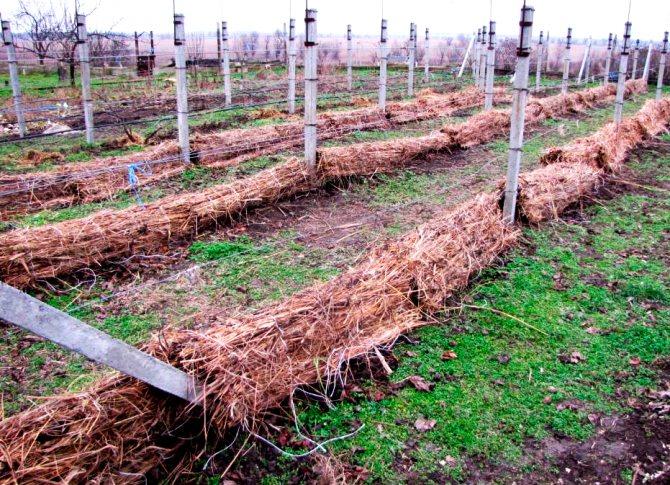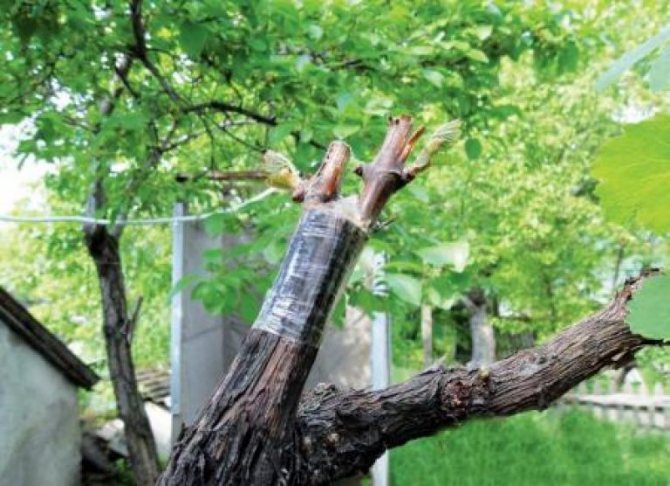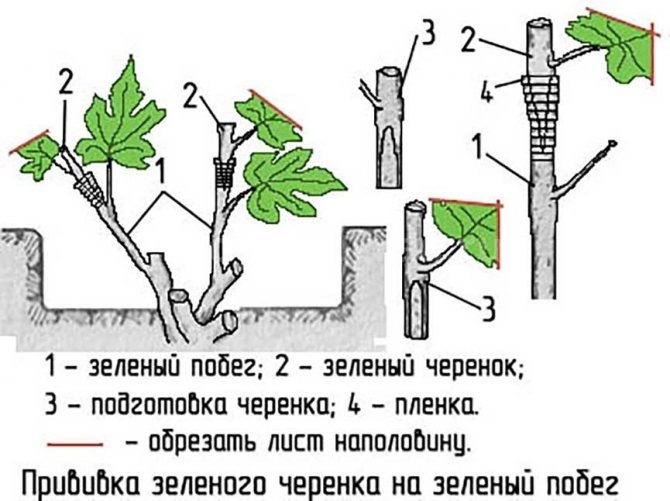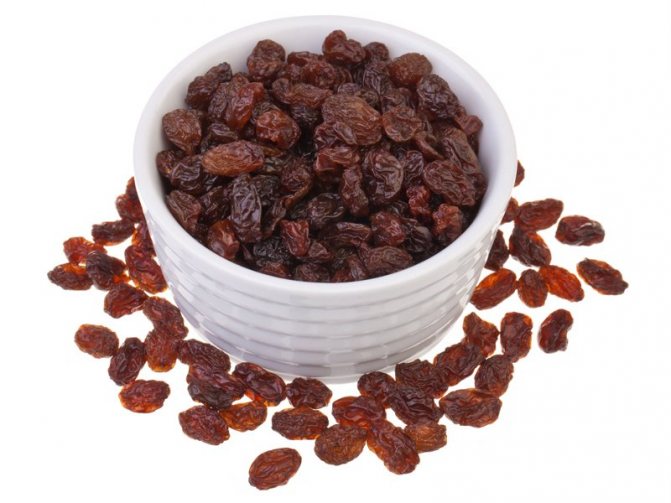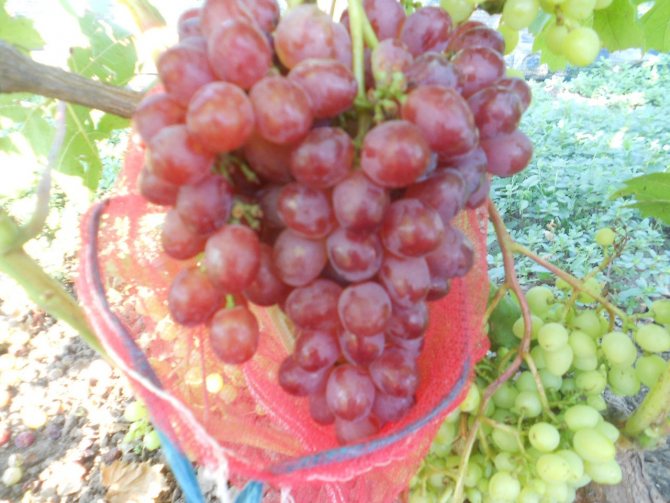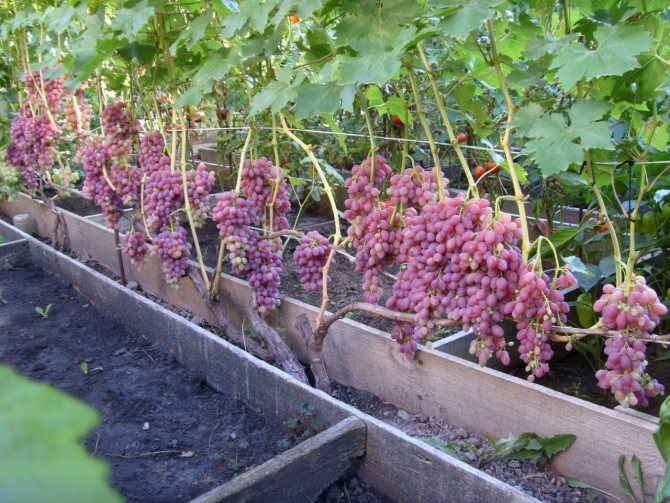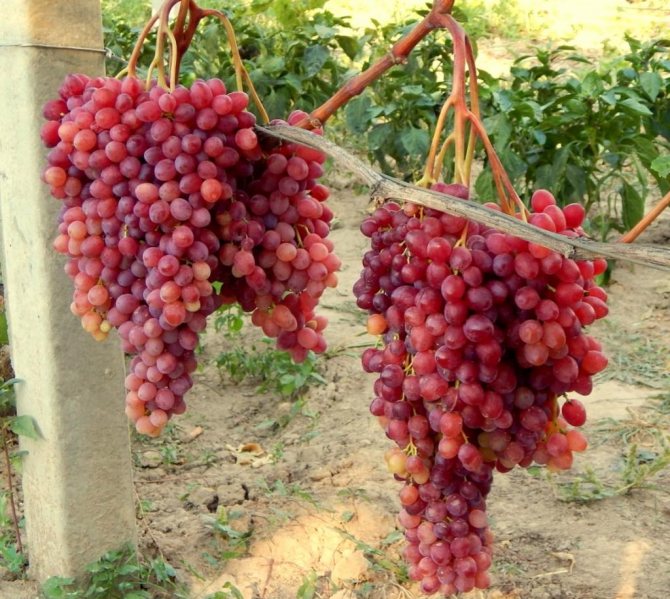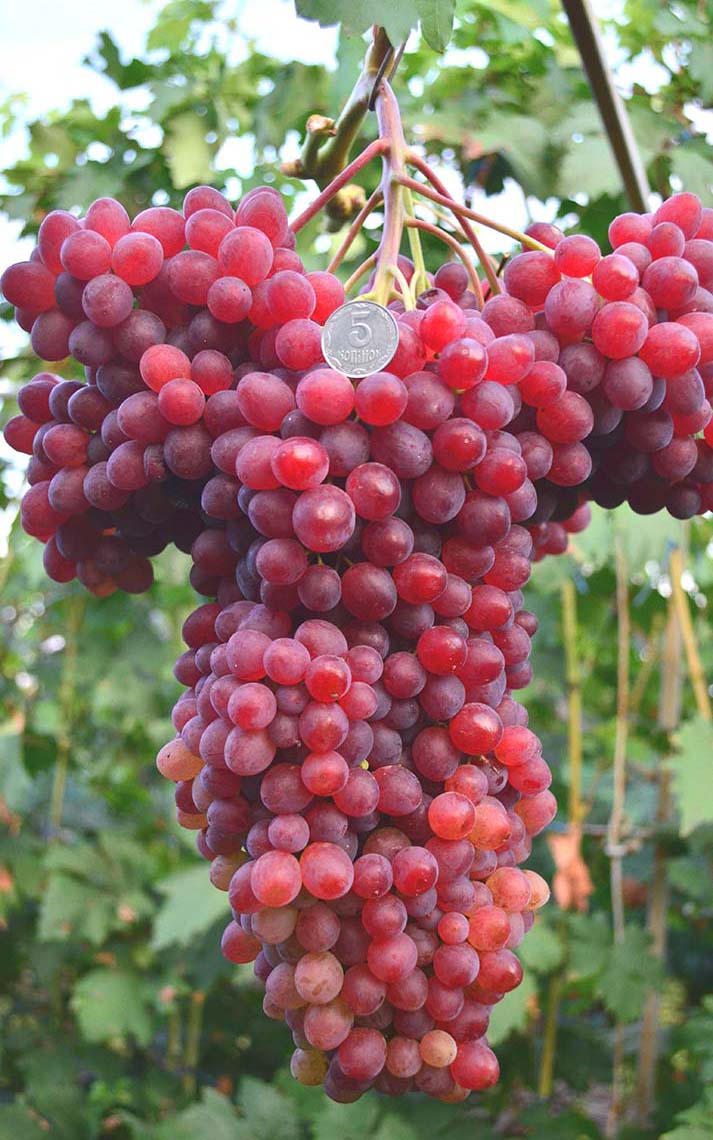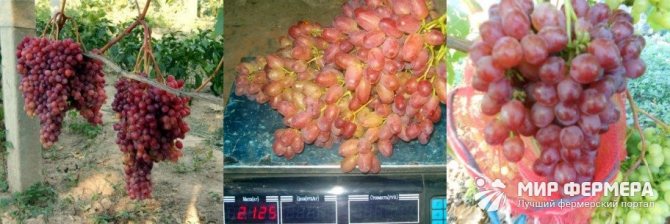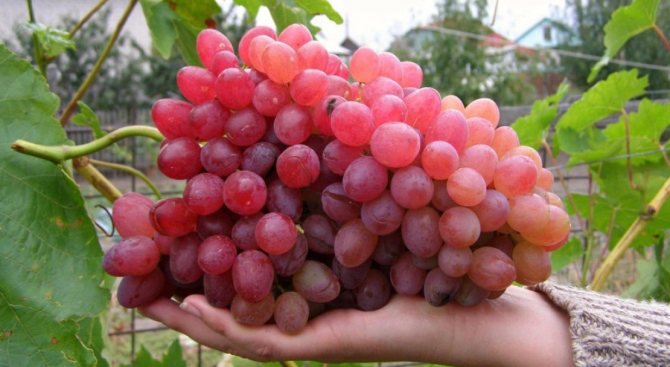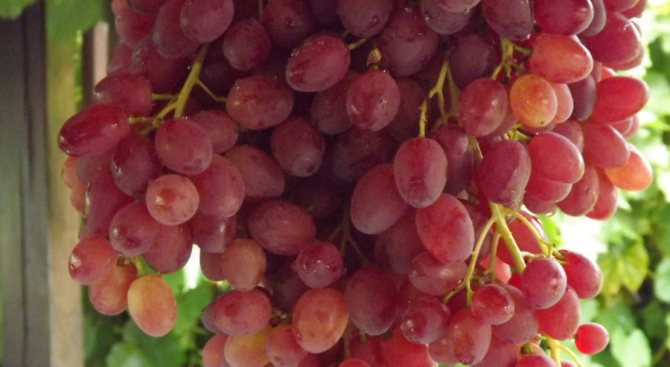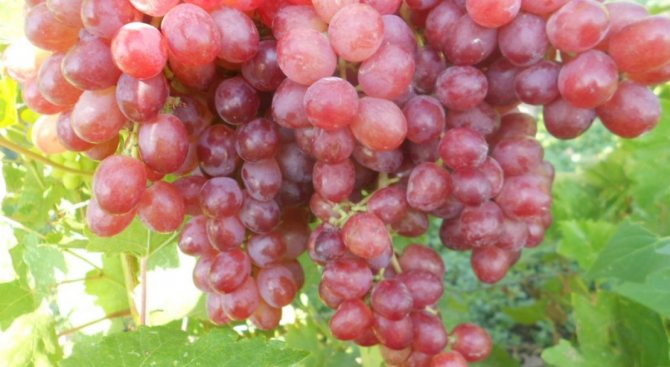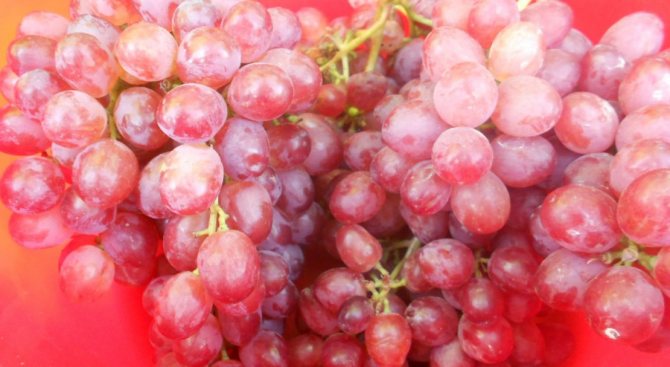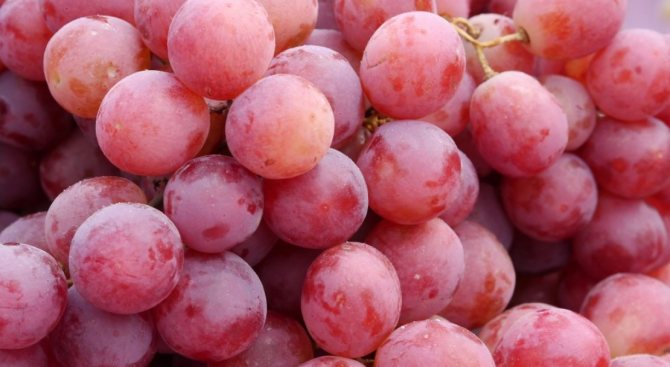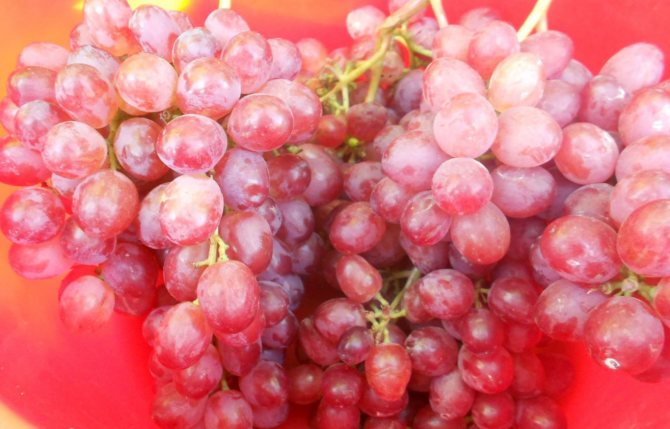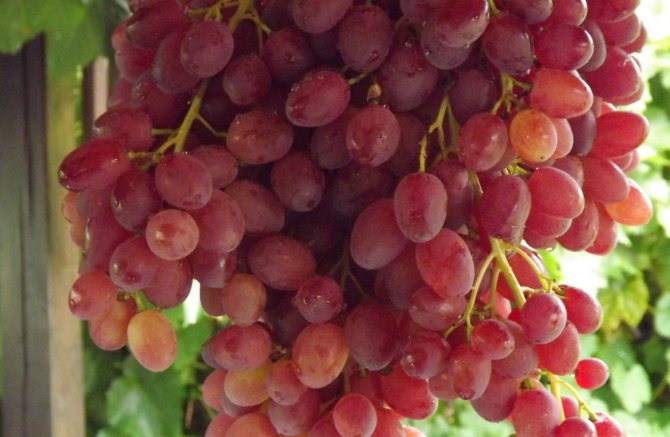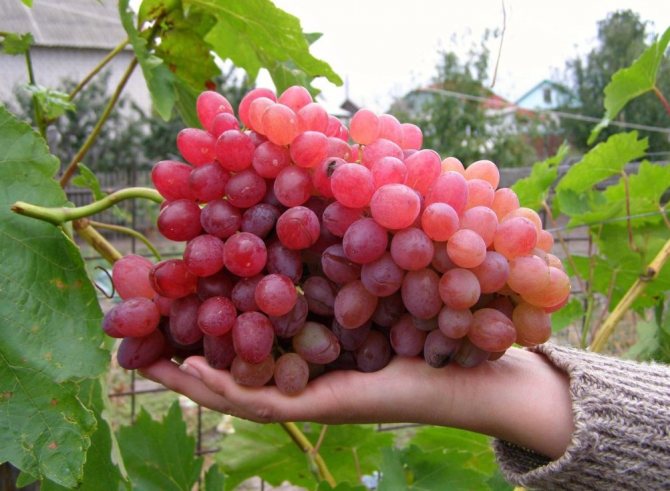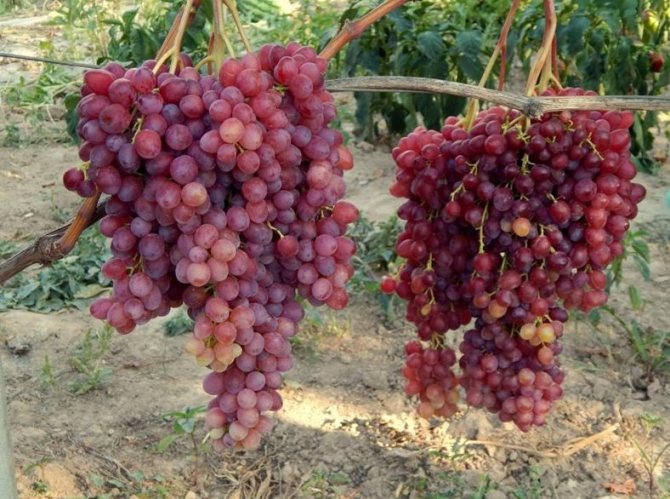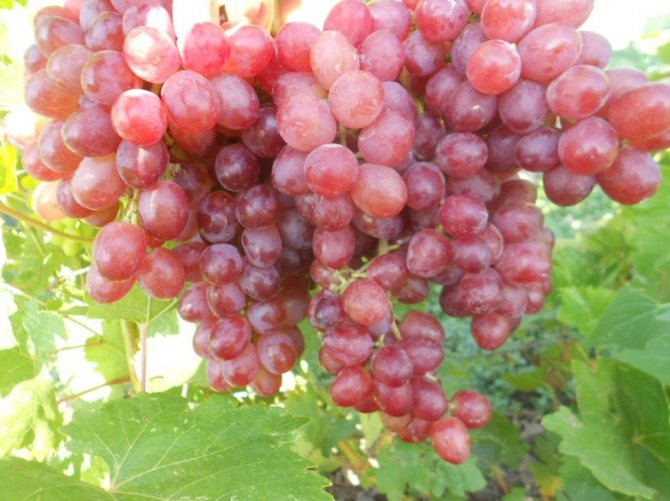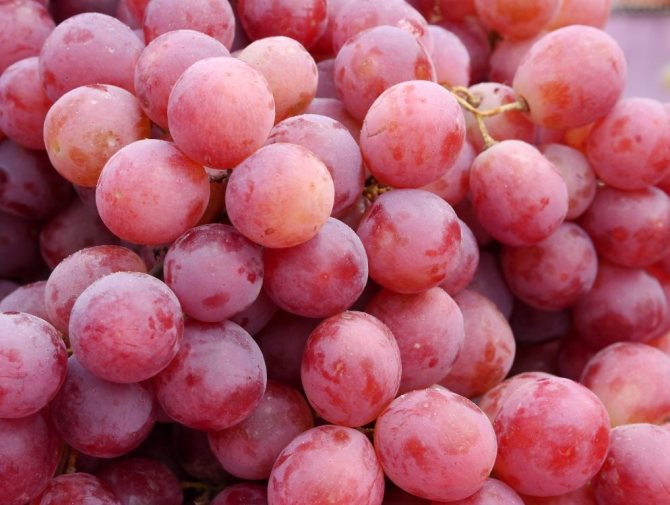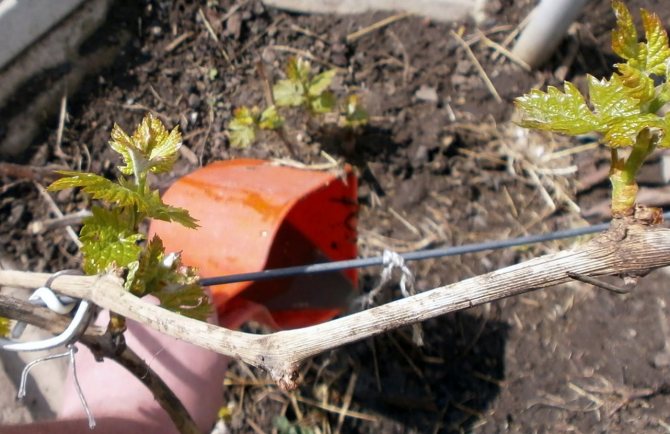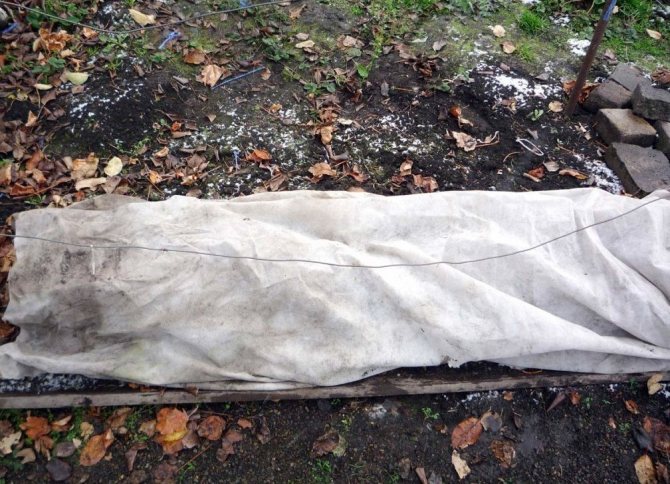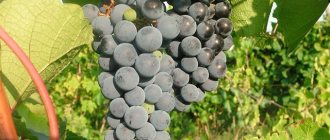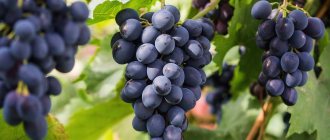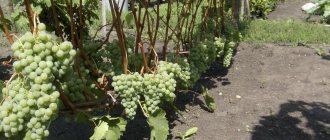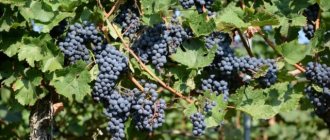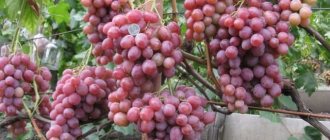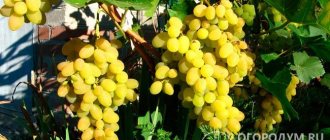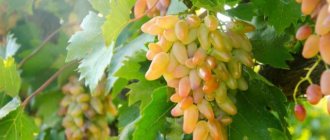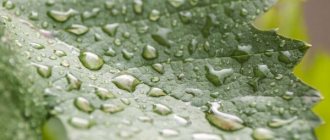Veles is an early ripe seedless hybrid of grapes, bred in 2009. The variety is distinguished by its high yield, good taste, as well as unpretentious care. From one bush of such grapes, you can collect from 10 kilograms of berries, subject to all requirements for agricultural technology, this indicator can be significantly increased. The variety is resistant to various diseases, as well as negative environmental factors, including frost. In this material, we will consider the main features of this hybrid, the characteristics of its vines and bunches, recommendations for planting, as well as further care for the Veles bushes.
Description of the variety with a photo, characteristics
Veles is cultivated by winegrowers from Ukraine, Belarus, Central Russia and the Far East. The ripening period of the grape bunches is short - from 95 to 105 days. The bunches begin to ripen in early August. The main characteristic of the hybrid is yield.
Apparently because of its fertility, the author gave the variety the name of the Slavic god of fertility. The yields are stable, annual. The increased yield can be explained by the tendency of the hybrid to form stepchildren, on which the formation of bunches is taking place. The bushes are distinguished by strong growth, seedlings and cuttings take root well. Frost resistance (-21 °) of grapes allows it to be grown in a cover culture in regions with moderate climatic conditions. Bushes need formative pruning. Apply medium (6 eyes) and short pruning.
The maximum weight of the bunch is fixed at 3 kg. Such a result is obtained by experienced growers with proper care of the bush. The average hobbyist can expect bunches of one kilogram or less. The bunches are not dense, loose, conical, dimensions 20 cm * 30 cm. The average weight of a berry is 5 g. The skin on the berries is thin, can be damaged by wasps, and crack from excess moisture in the soil and air.
The pulp and aroma contain notes of nutmeg, the taste of the pulp is original. The hybrid belongs to seedless (3rd class) forms of grapes; when analyzing its characteristics, a comparison is made with Radiant raisins. Veles' seeds are small, underdeveloped or completely absent, they are not felt during meals.
Ripe, pink berries acquire a delicate shade of amber. Bunches well illuminated by the sun are colored brighter. Due to their beautiful color, large size, the clusters are attractive and have a market value. On the bushes of Veles there are flowers for women and men. There are no pollination problems. Additional pollination guarantees a 20% yield increase.
Drought, sunny weather do not affect the presentation of the brushes, but prolonged rains, damp cold weather can leave their mark on the presentation of the bunch. Berries in such weather often burst, this worsens the presentation, reduces the consumer value of the variety. Ripe bunches can be cut off in no hurry. For up to 45 days, they hang on the bushes, preserving their taste and presentation. In this case, protection from wasps is needed, they can damage the thin skin of the berries.
Due to the lack of knowledge of the variety, due to its relative novelty, there are no exact data on the attitude of the variety to diseases. Judging by the comments of winegrowers, it can be assumed that the possibility of fungal diseases is quite high.Accordingly, the hybrid needs regular (3 times per season) measures to prevent fungal infection. In relation to diseases, the author rated:
- 3.5 - for resistance to mildew;
- 3.5 - for resistance to powdery mildew.
How to care for the Veles variety
Providing the necessary care, you can count on a rich harvest. Agrotechnical rules for growing are set out below.
Watering and feeding
For an adult plant, watering is required only 4 times per season. With waterlogging and stagnant moisture, fruits can crack and roots begin to rot.
A bucket of cow dung, along with half of this amount of bird droppings, is poured into 40 liters of water, insisted for 7 days. A liter of the composition is diluted in 10 liters of water. This amount is needed for each bush. This top dressing is done in April.
When the bush fades, 10 g of ammonium nitrate is needed for each square meter.
At the initial stage of ripening of berries, a mixture is used for feeding: superphosphate (30 g), nitrophoska (20 g), ash (50 g) are dissolved in a bucket of water.
Important! Every three years, when digging in September, add 6 kg of dry cow manure to each plant.
Bush formation and pruning
One of the distinguishing features of this grape variety is the formation of a large number of stepchildren. In the southern regions of Russia, this could provide another crop. In order for the stepsons to develop, they must be pinched. This will not happen in the rest of the country. Therefore, stepchildren must be removed so that the plant does not waste its vitality on them.
Planting and leaving
Veles is propagated by cuttings, seedlings. Bushes grown from seedlings come into fruiting earlier. The cuttings are rooting well, but the first harvest will take longer. It makes no sense to give the same recommendations for choosing a place to beginner winegrowers from the south, Siberia or the Moscow region.
If in the south, light shading of the bush in the middle of the day is welcome, then in the Moscow region the same shading will slow down the ripening of the shoots. We can conclude from this - for a temperate climate, the sunniest part of the garden is the best choice. In hilly areas, preference is given to the southern and southwestern slopes. Vine bushes receive 10% more heat.
When planning a vineyard, consider the cardinal points. The vine's illumination depends on the orientation of the trellis. Plant seedlings in one row, arrange it from west to east. If the plantation will consist of several rows, then it is better to arrange them from north to south. In regions where winds often blow, the wind rose should be taken into account. Place the trellis downwind.
Sapling selection
When choosing a seedling, a beginner winegrower can be advised:
- Do not buy seedlings with leaves and an open root system in the fall. Competent sellers cut the leaves, as they cause the seedling to lose moisture faster.
- Do not buy early seedlings. In the south, digging begins in October.
- Check the root system of the seedling to avoid buying a stuck shoot.
- Check if the seedling is alive or dry. If you scrape the bark of a live seedling, it is green and damp. The roots of a live seedling on a break are white.
Parameters of a good lignified seedling: height about 40 cm, thickness of the vine with a pencil, buds on the vine at least 3, roots 15 cm long and more.
Young seedlings should not be planted between mature vines. If a hole is dug on the site of an old vineyard, then it is made large and filled with a large amount of organic matter. When arranging a vineyard in a place free from trees, a hole is dug 80 cm by 80 cm.It is not worth planting in shallow holes, especially on loam, young bushes will sooner die than give a good growth. The planting hole needs to be well filled with organic matter, to ensure good drainage. In a properly filled hole, the roots will develop well.
Fill the holes with a mixture of earth, humus and sand.Adding sand is especially important on heavy loams and dry chernozems. Drainage made of stones:
- large crushed stone;
- gravel;
- broken brick;
- expanded clay.
Filling the pit: the first layer is a shovel of ash and 1.5 cups of superphosphate, the second layer is drainage (15 cm), the third layer is fertile soil (15 cm), the fourth layer is a humus mound (4 buckets). 2 buckets of water are poured onto the humus. The seedling is placed on top of the cone, its roots are straightened along the slopes of the cone. The entire planting pit is filled with a fertile mixture. The upper bud of the seedling is left above the surface. The pit is covered with mulch.
Caring for Veles grapes is standard, little different from caring for other table varieties. A planting pit well filled with organic matter and mineral fertilizers supplies the bush with nutrients for 3 years. Starting from 4 years old, it is necessary to carry out top dressing.
The formation of a bush is required. The recommended load on the bush is 35 eyes, this is taken into account when conducting formative pruning, 6 to 8 eyes are left on the shoot. In the spring, from 2 to 4 inflorescences are left on fruiting shoots. The litter is self-pollinated, but the use of gibberellin improves the setting of berries and their size.
A feature of the Veles variety is the active formation of stepchildren. In temperate climates, they must be removed as they appear, and left in the south. In a warm climate, stepchildren get a second crop, the clusters on stepchildren are smaller, but they have time to ripen before the cold weather. The first harvest period is early-mid-August, the second (in the south) - mid-autumn.
Veles grape bushes do not need to be watered often. There are certain periods of development of the grape bush when watering is necessary:
- opening of the first buds on the vine;
- the beginning of flowering;
- the initial period of fruit formation.
After each watering, mulch the soil with peat, sawdust, moss, humus. The optimum layer thickness is 3 cm; a larger layer of mulch will impair air access to the roots.
In the fall, cut out the fruit bearing lashes and young shoots with mechanical damage or immature. Shoots with signs of infection are subject to cutting and destruction. Veles is formed into 4 sleeves, each shoot has 6-8 eyes.
Read also: Caring for peppers in the open field and in the greenhouse
In the south, Veles winters well, and in temperate climates it needs to be covered for the winter. It is not a problem for a young seedling to build a shelter. Any container without a bottom is suitable for this purpose. It is installed over the seedling and filled with earth, humus or sawdust. After the autumn pruning, adult bushes are removed from the trellis, laid on the ground, and a shelter is built from arcs and covering material. The stem of the bush is spud.
Landing rules
The key attention should be paid to planting raisins Veles grapes, since the complexity of further caring for it will depend on this.
Note: Fortunately, the hybrid is considered unpretentious, and you can grow it on the site not only from the seedlings purchased in the nursery, but also from the planting material obtained on your own.
It is advisable to plant pre-purchased seedlings or inoculation of harvested cuttings in the spring. So the plant will have time to get stronger before the onset of cold weather. If on your site there is already a bush of grapes that has not been bearing fruit for a long time, you can graft the seedling onto the old stock (Figure 3).
If you bought a seedling from a nursery, the procedure will be as follows:
- The best soil for a crop is considered to be a nutritious soil that allows moisture to pass through well. Ideally, this should be black soil, but if the soil in your dacha is far from ideal, you can easily fill the hole itself with soil mixture.
- The place for placing the culture should be well warmed up by the sun. At the same time, it is extremely undesirable to plant plants in swampy or open areas blown by the wind.
- If you are going to plant not one, but several plants at once, keep in mind that the vine is actively gaining green mass. Accordingly, the distance between individual bushes should be one and a half to two meters, and the distance between rows or bushes and buildings should be 3-4 meters.
- The depth and diameter of the planting hole must be at least 80 centimeters. A drainage layer is poured at the bottom, and then the pit is filled with a mixture of humus and phosphorus-potassium fertilizers. Sprinkle them on top with nutritious soil so that the seedling does not burn the roots.
- Before planting seedlings, they are placed in water with a solution of a stimulating drug. This will help young plants to quickly take root and take root in a new place.

Figure 3. Technology of planting seedlings
When the landing site and the planting hole are prepared, a seedling is placed in the center of the pit, its roots are carefully straightened and sprinkled with soil. Next, you need to slightly compact the soil and water the plant with 2-3 buckets of water. So that moisture does not evaporate from the soil so quickly, it is advisable to mulch the near-trunk circle with sawdust or peat.
Grapes Veles: video
In our climate, Veles raisins show excellent results. By August, it is gaining sugar, ripens. I note the good maturation of the vine and the absence of sores.
Constantine, Nevinnomyssk
Standing raisins, suffering from wasps due to thin skin, you need to put on bags for protection.
Received the signaling from last year's bush, obtained from brilliant green. Strong bush, developed well. I shortened the brushes during flowering, left two for testing. The taste suits, the size of the berries is small, but it is too early to judge the size. I will be evaluating it next year.
Tatiana, Voronezh
I grow Veles for sale, it is flying in. I always shorten the brushes during flowering, but I cannot achieve uniform ripening, the clusters are very large. A small part of the berries crack in rainy weather.
I do not like the uneven color of the bunch, the disheveled shape. I overcame the desire to cut the bushes of Veles, I am waiting to see how it will show itself in the future.
Gleb, Novoaleksandrovsk
The bushes of Veles, planted near the house, are tall, productive, give large clusters. The berry is large, tasty, ripens early. I tried to plant Veles in the field, but there is better Radiant.
Andrey, Saratov
The variety is decent, but capricious, susceptible to powdery mildew. Fruiting later - in the 4th, 5th year. From oidium, fruiting buds are cut out, berries rot. Fungicides are indispensable. On the Internet, you can buy a Cabrio top, this is for the kidneys, and so that the berries do not rot Abiga peak or Tobit jet.
Veles grapes
Seedless grapes have always been popular with consumers. Breeders do not stop working and get new varieties and hybrids that ripen quickly and at the same time have an attractive presentation. In 2009, a new grape variety Veles appeared, thanks to the labors of the wine grower V.V. Zagorulko. The variety was bred on the basis of Rusbol and Sofia grapes, has large, early ripening bunches. The variety is named in honor of the Slavic god of fertility Veles.
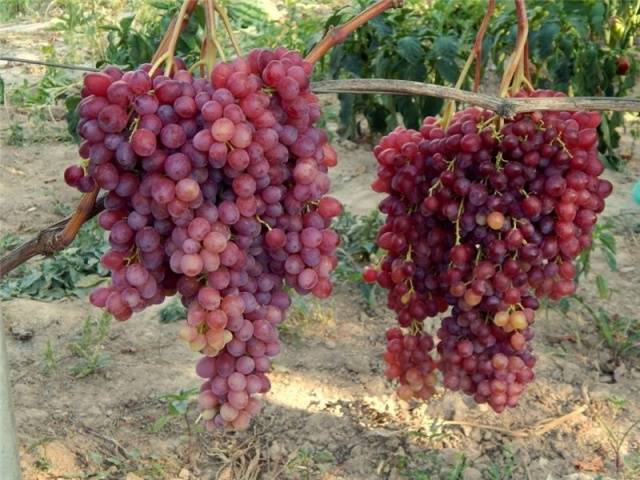

Breeding history
The famous amateur breeder V.V. Zagorulko, living in Ukraine in Zaporozhye, crossing varieties
Sofia
and
Rusball
, has developed a relatively new variety of seedless grapes.
Breeders have long sought to create varieties with almost invisible seeds. Veles is one of them.
Asya, Ruta and Vodograi belong to the hand of the same breeder.
The year of creation of this grape was distinguished by unusual weather conditions, and the ratio of the mass of rudiments increased even in completely seedless varieties. Veles was assigned the 4th category, which means the ratio of rudiments is more than 14 mg.
Description of Veles grapes
Veles grape is a hybrid early ripening variety. From the appearance of the first leaves to the ripening of the fruit, it takes about 100 days. The vine of the Veles variety grows and matures rapidly. One fruiting shoot forms 2-4 flower clusters. Flowers are bisexual.The plant does not need additional pollination, but if you want to increase the yield, you can resort to artificial pollination.
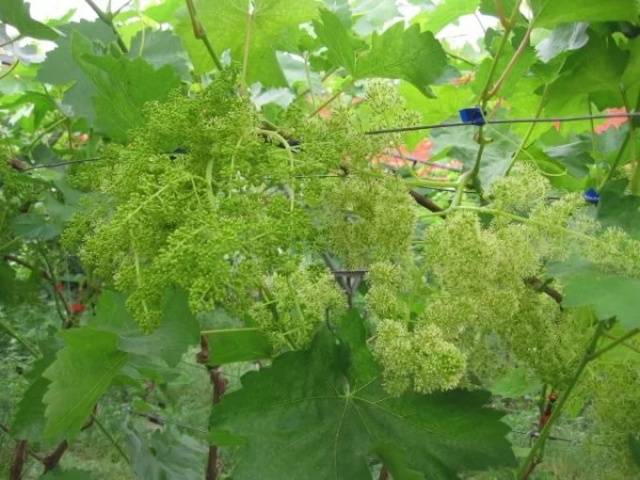

In the process of harvest maturation, stepchildren are formed on the vine, which can give an additional harvest by mid-September.
In the description of the Veles grape variety, the mass of a bunch of grapes is indicated from 600 g to 2 kg, according to reviews and photos of winegrowers, a brush can ripen up to 3 kg. The shape of a bunch of Veles grapes is cone-shaped, very voluminous, not very dense or loose.
Berries are oval in shape, weighing up to 5 g, the skin is thin, but rather dense, does not allow the berries to crack, the color of the berries is pink with the technical ripeness of the fruits, only rudiments remained from the seeds - seed rudiments that are not felt when eating.
Thanks to the thin skin of the Veles variety, the berries are translucent in the sun, which makes them aesthetically attractive for the buyer. The flesh of the berries is dense, jelly-like, of pleasant taste with a nutmeg tint.
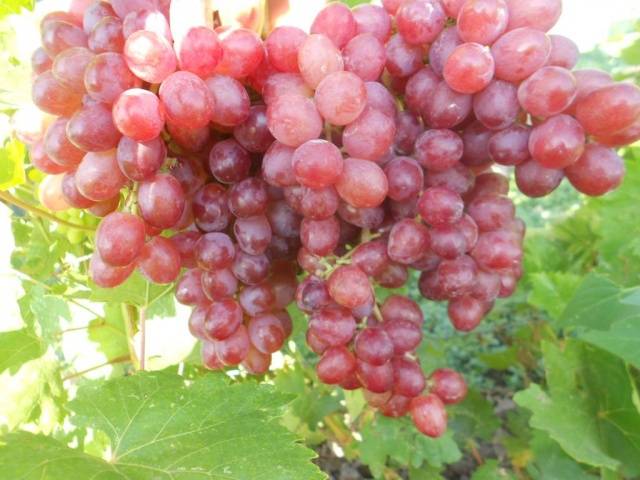

Veles kishmish grape is a frost-resistant variety that can withstand temperatures as low as -23 ° C. Suitable for central Russia, if the plant is covered for the winter. In the southern regions, 2 harvests are possible.
Watch a video about the Veles grape:
Pros and cons of the variety
There are a lot of advantages of the hybrid Veles raisin grape, which explains its popularity among gardeners (Figure 2).
The main positive characteristics of this grape with bright pink fruits are:
- Early maturity: from the moment of swelling of the kidneys and until the fruit is fully ripe, only a hundred days pass. This property makes the variety versatile, because it is suitable for both southern and temperate climates.
- Frost resistance: in the south, it is customary to grow the vine without shelter. And although the culture can withstand a temperature drop of -23 degrees, in temperate and northern climates it is better to cover the vine for the winter so as not to provoke freezing of the shoots.
- High yield: the number of formed ovaries practically does not depend on the care of the crop. If you have chosen the right place for placing the grapes and correctly planted it, an adult vine will produce quite a lot of fruits for several years.
- High consumer value: the fruits of Veles have not only excellent taste, but also an attractive appearance. In addition, they are suitable for long-term transportation without losing their presentation and can be kept fresh for a long time in the refrigerator.
Along with its merits, culture also has certain disadvantages. First of all, the hybrid does not have a high enough resistance to fungal diseases, therefore, preventive spraying should become an obligatory stage of care.


Figure 2. A hybrid has many advantages, but there are also disadvantages.
In addition, with excessive watering or too frequent rains, the berries can begin to crack, so you should take care of drainage even at the planting stage. The gardener's attention will also be required at the stage of fruit ripening: they are a favorite delicacy of wasps, and in order to protect the crop from these insects, each bunch is packed in a separate gauze bag or poisoned traps are set next to the vineyard.
Features of growing grapes
The planting of the Veles variety is carried out either by cuttings harvested in the fall, or by ready-made seedlings. Young plants take root well in any case and can give the first signal fruits already in the second year. It is recommended to remove the inflorescences that have appeared so as not to delay the forces of the seedling for the development and ripening of fruits, but to send them to the ripening of the shoots.
Veles grapes do not make high demands on the quality of the soil. It can grow on sandstones, loams or clay soils. Regardless of the soil, humus, peat or compost is placed in the planting hole, mixed with the soil.Broken brick is placed at the bottom of the pit, expanded clay for drainage, if the soil is dense clay. Despite the fact that the seedling is still small, the size of the planting pit should be at least 0.8x0.8 m.
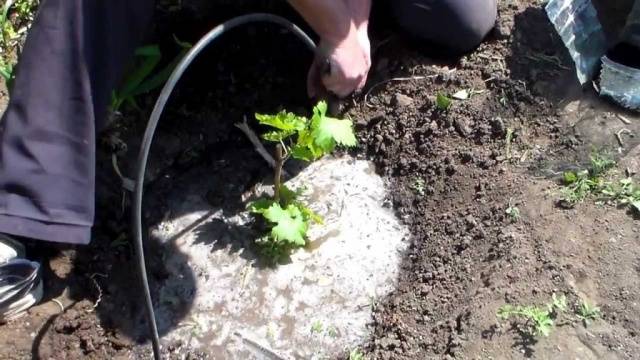

When planting the Veles variety, take into account the direction of the rows from north to south and the distance between the seedlings at least 1.5 m. The planting pit should be filled with organic matter as well as possible, since this is food for grapes in the next 3-4 years. You can add superphosphate (300 g), ash (500 g), potassium salt (100 g).
While the plant is young, it will require more careful care. Loosen and water regularly, remove weeds. Covering the topsoil under the grapes with mulch can reduce maintenance as mulch inhibits the growth of weeds and reduces moisture evaporation. Peat can be used as mulch.
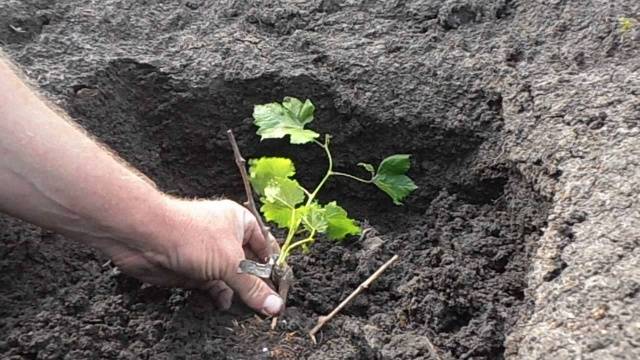

An adult plant of the Veles variety does not need frequent watering, especially when the fruits ripen, excess moisture can cause cracking of the berries and their decay in Veles grapes. Watering is carried out no more than 4 times per season, at the most crucial moments of plant development.
Be sure to arrange support when landing. It can be a simple trellis made of a dug-in base - pillars and a wire stretched between them in several rows. The wire must be strong enough and taut enough to withstand the considerable weight of the grapes and their ripening fruits.
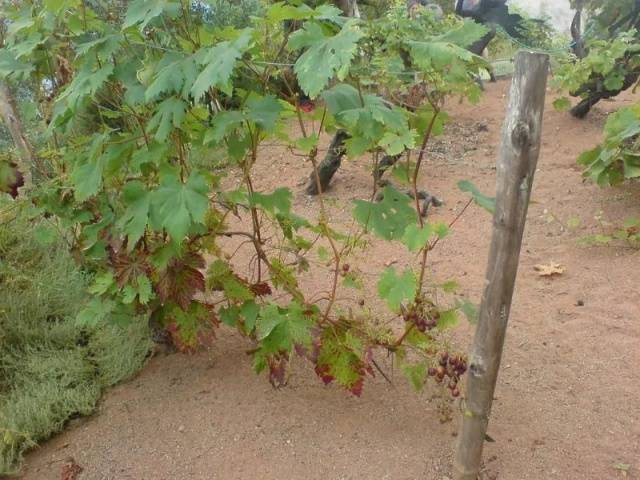

A sufficient amount of space is left between the trellises, convenient for leaving, organizing shelter, it is important that the Veles grape bushes do not shade each other, and they have enough sunlight and heat. The minimum distance between rows of trellises is at least 3 m.
Features of watering the vineyard
You need to water the grape bushes at least once a month, starting in May. If it was a dry summer, then watering should be done more often (once every 2-3 weeks).
Irrigation is carried out according to the schedule, not paying attention to rain, since in order for the plant to receive a sufficient amount of moisture, about 60-80 liters of water are needed.
In order not to form crusts on the soil after irrigation, the soil is covered with a layer of mulch of about 5-8 cm, which protects the soil from drying out and also additionally enriches the soil with microelements.
Watering is combined with top dressing of the vineyard. Usually, for these purposes, a barrel of warm water is prepared in advance, in which organic or mineral fertilizers are dissolved. On both sides of the bushes, ditches are dug in the row spacing. They are made at a distance of a meter from the trunk of the grape bush, because this is where the plants feeding the roots lie. The depth of the groove is approximately one spade bayonet.
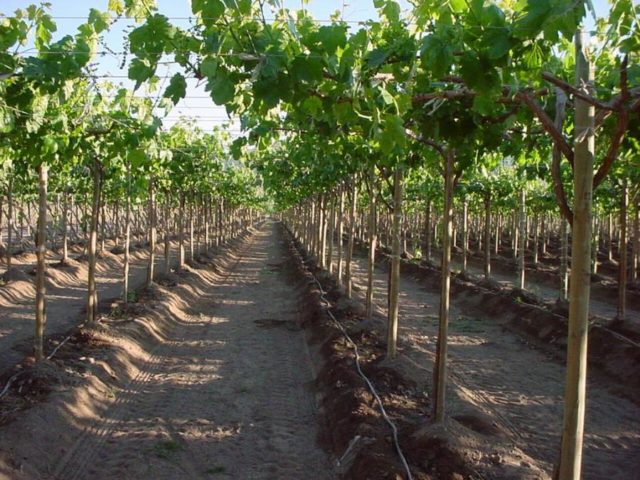

Young bushes (up to 3 years old) are watered in the near-stem pits or in a special pipe, which is sometimes left for watering seedlings.
How to tie and pinch grapes
During the growing season, the shoots of Veles grapes will need to be repeatedly tied to several rows of trellises. Why is tying shoots done?
- The crowding of leaves and shoots is negated when the green mass shades each other, while not receiving enough sunlight;
- It makes it easier to carry out work on the care of the vineyard. It is much easier to carry out foliar fertilization, pinching and removing shoots from Veles;
- Shoots in a tied position grow strong, ripen faster;
- Tying grapes is the prevention of diseases, the airing of shoots and leaves is improved.
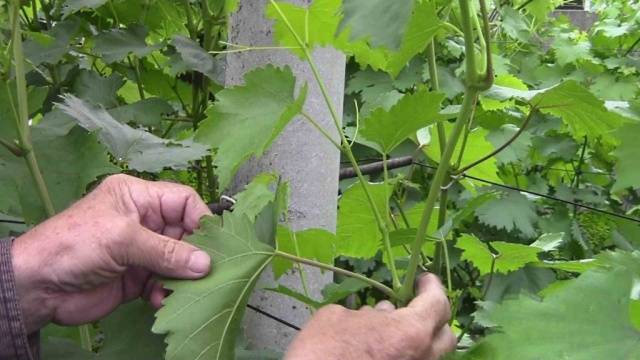

When the shoots reach a size of 30-40 cm, they are tied up in the lower trellis, then, as they grow, they are fixed to the next rows of wire.
The garter material can be twine, twine, trimming of textile or knitted fabric. It is required to fix it reliably, but with some margin, so that the growing shoot in the future does not turn out to be overtightened.Manufacturers offer winegrowers special plastic clips that are very convenient to use and designed for repeated use.
A feature of the Veles grape variety is its ability to form multiple shoots of the second order. In the southern regions, they may well grow a second crop. But in the middle lane, a large number of shoots will only draw off the forces of the bush, preventing the crop from ripening quickly and shading the bush, which is a negative factor in the development of diseases. Therefore, the stepsons should be removed completely, and in the southern regions, pinch the upper part.
Read also: Bitter almonds: description, properties, benefits and harms
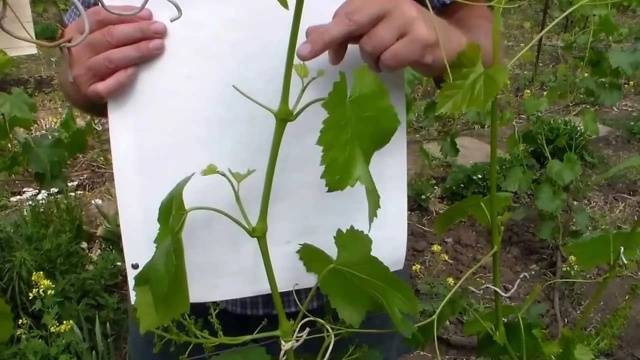

Pruning and sheltering for the winter
Formation of Veles grapes is most often fan-shaped. The vine is cut and tied in such a way that four strong sleeves are formed on the bush. To maintain the shape of the crown, regular spring cleaning and autumn pruning are carried out. In addition, medium pruning is recommended in the spring.
Its essence lies in the fact that 6-8 eyes are left on each shoot. In this case, the total load on the bush will be 25-35 buds. This amount is quite enough to obtain a rich harvest, but the crop itself will not suffer from overload (Figure 6).
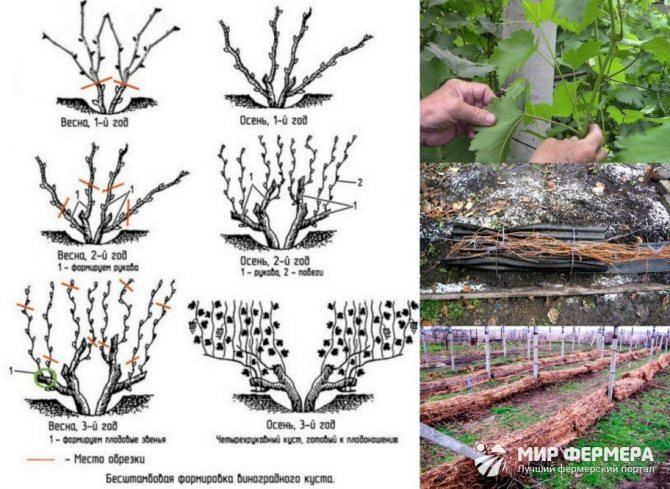

Figure 6. Forming pruning technology and winter shelter options
The final step in caring for the grapes is to shelter it for the winter. In the southern regions, the plant tolerates winter well without additional shelter, but in temperate and northern climates, some protection from frost is still required.
To prepare the culture for winter, the shortened vine is removed from the trellis, sprayed against diseases for prophylaxis, bent to the ground, pinned and covered with agrofibre. Some gardeners advise covering the grapes with foil, however, such a shelter is not recommended due to the risk of damping off pbegs.
Preparation of protective structures for grapes
The Veles variety tolerates the cold of the middle zone well. However, the organization of a shelter will be required. To do this, in the fall, the grapes are removed from the trellis, cut off, preventive treatment for diseases is done, and covered with film or agrofibre.
Pruning Veles grapes is an obligatory stage of plant care, which not only facilitates the wintering of plants, but also forms the future harvest. For the Veles variety, it is recommended to prune 6-8 buds of each shoot. Usually, in the middle lane, pruning occurs at the end of October - beginning of November.
For more information on protecting grapes for the winter, see the video:
Shelter should not be organized right away. Until the temperature reaches -10 ° C-12 ° C. The first frosts are beneficial for Veles grapes, as they harden it and prepare it for lower temperatures.
Old bushes of the Veles variety tolerate winter frosts much easier, a sharp drop in temperatures is most detrimental to young plants. They need to be covered most carefully. The grape shoots removed from the trellis should not lie on bare ground. A substrate is used between them. For example, sheets of slate or boards.
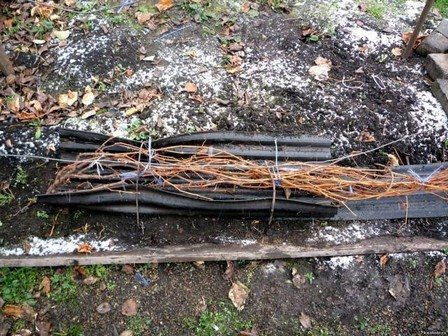

Further, from above, the grapes are covered with spruce branches, straw, or simply covered with earth, taking it from the rows. Combined protective structures for grapes are more effective. Example: covering the plants with spruce branches, stretch a film or agrofibre on top, securing them around the perimeter with bricks. The fallen snow will additionally insulate the structure.
Another example of a defensive structure is wooden or plywood panels covered with agrofibre or plastic wrap. They are placed over the laid lashes of Veles grapes at an angle, in the form of a hut. The advantage of such shelters is their repeated use over several years.
Another way to shelter Veles grapes for the winter. Special trenches are dug under the vine.Grapes removed from the trellis are placed in them, fixed with metal hooks. Arcs are installed on top at intervals of 0.5 m. Covering material is stretched over the arcs, which is fixed on the sides with bricks or pegs. While the weather is positive or with a slight minus, the ends of the shelter are not closed. But as soon as the weather settles with an air temperature of -8 ° C-10 ° C, the ends are reliably closed.
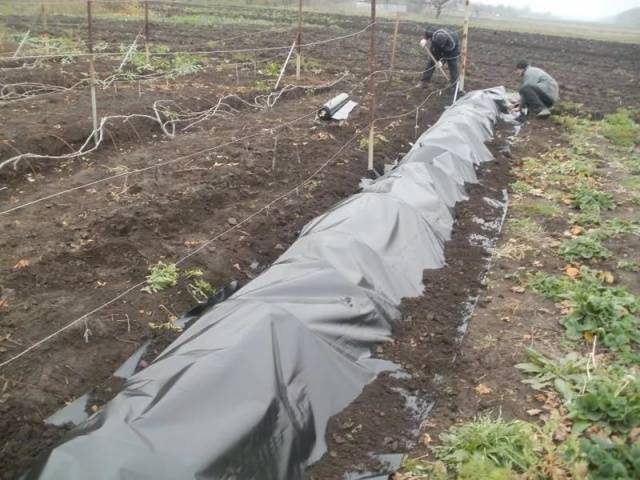

Testimonials
We will find out what domestic winegrowers think about the cultivation of this variety.
- Elena, 43 years old, Sochi: “Veles planted grapes not so long ago - three years ago, but he already managed to surprise me with his taste and incredibly huge bunches. Even bunches exceeding 3.5 kilograms were disfigured - all the neighbors came to see. Our climate is warm, so for the winter I cover it with a thin film - just in case, but I think it will winter well even without shelter. In the northern regions, of course, you cannot do without shelter. In general, the care is simple: the main thing is to cut it correctly so that the clusters are of high quality, and fertilize well, naturally - water. And then Veles grows remarkably. I recommend this variety as a record-breaking variety with very high quality berries. "
- Victor, 50 years old, Noginsk: “As you understand, not every grape variety grows in the middle lane - you need to choose carefully, and be sure to cover for the winter. But Veles surprised me - he wintered wonderfully under the protection of agrofibre, and in the second year after planting he had already given an excellent harvest. It is very important to cut it off correctly, leaving fewer eyes - then the clusters turn out to be large. And the choice of location also matters - the berries will be sweeter in the sun. By the way, seedless berries, which is also important. I recommend the variety as very productive and promising. "
This article will tell you about reviews of the Laura grape variety.
So, we examined the features of the Veles grape variety. This variety, which is, in fact, raisins, is distinguished by a rare yield and unpretentious care at the same time. Moreover, it is domestic, which means it is adapted to the realities of our changeable and complex climate. We recommend this variety as one of the most promising for today. In addition, Veles is best suited for cultivation in small private vineyards.
Veles grape variety
Every winegrower wants to have high-yielding, frost-resistant, self-pollinated varieties on his garden plot. So that the bunch is beautiful and the berries are sugary. So these properties are typical for Veles grapes.
In addition, an early ripening hybrid has one peculiarity: there are almost no seeds in the berries, and if they are found, then small seedless ones. That is, Veles belongs to the group of grape varieties under the general name "kishmish". This means that the berries can be used not only for fresh consumption, but also in the form of raisins.
The features of the variety, as well as the main agrotechnical measures for obtaining a high yield of grapes, will be discussed in this article.
Advantages and disadvantages of the variety
| Advantages | disadvantages |
| High marketability of the variety: pleasant nutmeg taste, radiant pink color, huge clusters. | Requires rationing of clusters and inflorescences |
| Seedless, only occasionally rudimentary seed remains | Due to the large weight, during ripening, the bunches can come off the bush, so you need to tie the bunches |
| High yield | |
| Early maturation | |
| Bisexual flowering type. |
Description of the variety
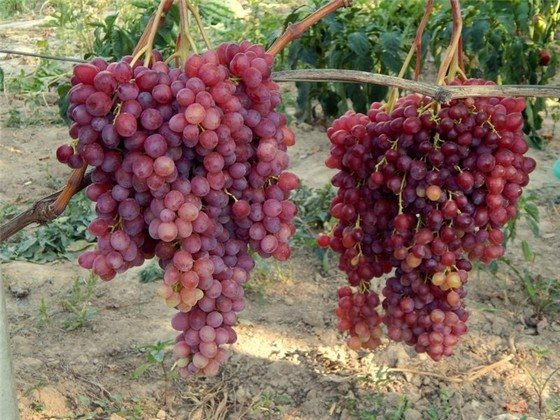

Veles grapes - the result of the work of the Ukrainian breeder from Zaporozhye V.V. Zagorulko. It was obtained as a result of crossing the table varieties Sofia and Rusbola (the second name is raisins Mirage) in 2009, and already in 2010 it was awarded two gold medals at one of the international competitions.
Veles is a hybrid of early ripening and surpassed the parent varieties in this indicator.The first berries can be tasted in August, that is, after 95–105 days from the beginning of bud break. True, these terms depend on the area of distribution.
In the southern regions, the harvest can be obtained a little earlier, in central Russia and Belarus later. The variety is acclimatized in the southern regions of Ukraine and Russia, but grows well and gives excellent yields in the Black Earth Region, the Volga Region, Belarus, as it has good frost resistance. The bushes are able to withstand a short-term drop in temperature up to 21 degrees.
Variety characteristics
The Veles hybrid has a number of positive qualities:
- high stable yield (6–7 kg per 1 bush);
- unusual taste and aesthetic appearance of berries;
- high resistance to fungal diseases (for example, mildew and oidimum);
- good transportability;
- good storage of berries on the bush (in dry weather, the brushes naturally turn into raisins and stay on the vine for up to 1.5 months).
Disadvantages:
- medium frost resistance (tolerates a drop in temperature to –21 ° C) - in cold regions it needs shelter for the winter;
- berries can crack and rot in high humidity conditions.
Bush characteristic
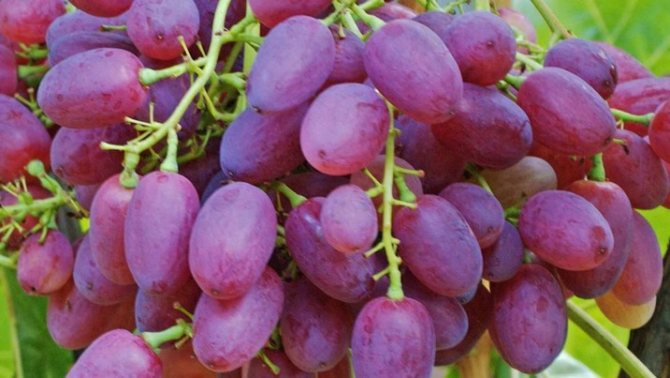

Veles bushes are vigorous. The vine reaches up to 3-5 meters in length. Flowers are bisexual, collected in large inflorescences. Leaves are green, five-lobed. There are notches between the lobes: two upper, two lower and petiolar. The edges of the leaf blade are bordered with denticles. By the end of the growing season, the leaves acquire a characteristic autumn color. Usually yellow or golden yellow.
The shape of the bunch is conical, loose, branched. The average length is about 30 cm, and the width is 20 cm. Weight 600-900 grams. But with proper care and the right load, pruning can reach about 3 kilograms.
The berries are oval, oblong, pale pink with a visualized waxy coating, each weighing about 5 grams. The pulp is dense with a delicate nutmeg smell. The variety is characterized by steno-sperm carp, when the development of the embryo and seed coat of the seed stops at the beginning of berry growth.
Important! With increased relative humidity, the berries can burst, while losing their presentation.
The appearance of the grapes
The bunches of this variety are branchy and very large. One bunch can weigh up to 3 kg. The shape of the brushes is conical or cylindrical. It can reach about 18 cm in length and 13 cm in width.
The berries are large, oval, of a beautiful pink color, with an amber tint. It looks transparent, very beautiful, weighing up to 5 grams.
The aroma of the fruit has slightly pronounced nutmeg notes. Due to the absence of seeds, the pulp is very tasty and dense. The skin is almost invisible and invisible when consumed.
The vine ripens very well, almost over the entire length of the shoot.
On the abundantly formed stepchildren on the bush, an additional crop can ripen by mid-October.
Yield
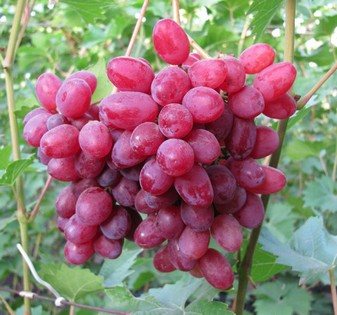

The yield of this variety is highly dependent on the quality of the pruning and the load on the bush. As well as timely performed operations for the care and prevention of diseases. The first crop can be harvested in mid-August. This applies to the southern regions of the country.
In more northerly grapes it ripens a little later. The variety is high-yielding, on average, about 6 kilograms of berries can be removed from the bush. If the bunches are not collected in time, then they do not crumble for a long time and the berries do not lose their taste and consistency.
Stepsons can form on the shoots and in October - early November a small second harvest will ripen on the bushes. Veles grape is transportable, therefore it retains its presentation for a long time. Usage is universal. It can be consumed both fresh and prepared from berries compotes, jam, raisins.
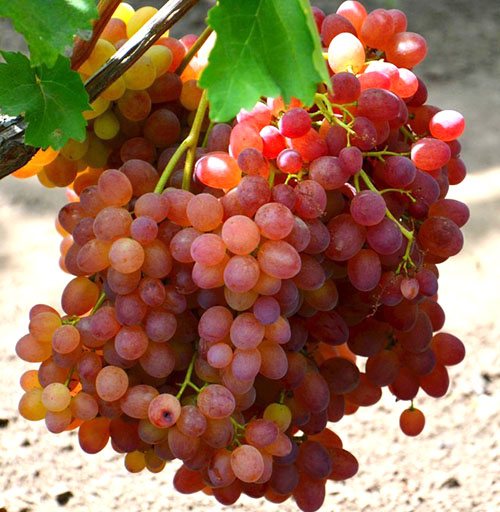

Although the Veles variety appeared on household plots quite recently, but, according to the reviews of amateur winegrowers, whose raisins have already begun to bear fruit, it has a number of such advantages:
- The variety is early and can be harvested in August.
- The bunches are beautiful, transportable. They keep their presentation for a long time.
- The berries have a high sugar content and a delicate nutmeg smell. There are no bones in them.
- The bunches on the bushes do not lose their presentation, the berries do not fall off for a month, even if they are not cut on time.
- The application is universal. That is, you can eat it fresh, prepare compotes, jam and raisins.
- High productivity.
- Frost resistance.
- The variety is self-pollinated.
- Rooting of seedlings is quick.
- Agrotechnical care measures are not difficult even for a beginner winegrower.
True, at the same time, the main drawback of the Veles grape variety was noticed. This is an average resistance against fungal diseases, which are mildew and powdery mildew.
Pests and diseases
"Veles" is a variety that was bred relatively recently, and therefore the susceptibility to various fungal diseases has not yet been studied.
But it was found that the variety has a very high immunity to mildew and oidium, about 3.5–4 points.
To prevent the disease of the bushes, preventive spraying is carried out three times during the ripening period. For the best effect, spraying with herbicides should be selected specifically for each type of disease.
To protect against birds and wasps, it is recommended to cover the bunches in special mesh packaging, which can be purchased in specialized stores.
Growing
Landing scheme:
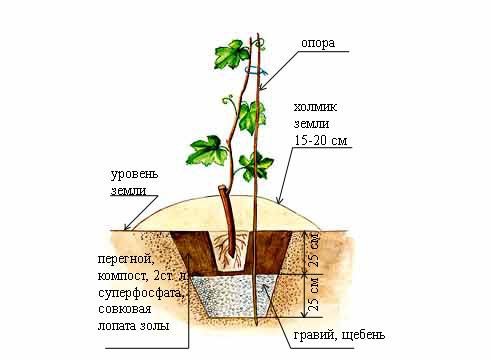

Planting of Veles grapes can be done with grafted or self-rooted seedlings. Or pre-prepared shanks.
Planting material requirements:
- Grafted seedlings. The fusion of the rootstock with the scion should be circular. The root system is strong and developed. And the growth is ripe, stiff, without mechanical damage. The length of the seedling is about 45 cm.
- Own-rooted. The same requirements as for the grafted, but due to the fact that they are less frost-resistant, then the length without growth for planting on heavy soils should be about 45 cm, but on light sandy and sandy loamy soils - up to 60 cm.
Read also: Honey pear: description, care features
In vineyards, seedlings are dug up in the fall. Therefore, they can be bought at the same time and planted on the site. But if it is not possible, then you can purchase planting material in the spring.
Important! It is advisable to buy seedlings in specialized nurseries or from trusted sellers, since purchasing them on the market, you can plant not the desired variety, but, for example, wine. It will be possible to recognize the substitution only in the third year.
Preplant soil preparation
The successful placement of the bushes will allow growing thermophilic grape varieties, such as Veles, for example.
This is best done on slopes because:
- The grapes receive more light.
- The sugar content of the berries is higher and they ripen faster.
- Bushes are less affected by fungal diseases, frost and late spring frosts.
- The frost-free period on the slopes is 20 days longer.
If this is not possible, then the site for laying grapes is leveled, stumps are uprooted, stones are removed. Then they dig up the ground. Planting is carried out on large areas for vineyards. In the fall, organic fertilizers can be applied. If this is not possible, then they are laid directly in the hole during landing. Rows are best positioned from north to south.
Important! In the southern regions and on marginal soils, the planting density of seedlings may be greater than in the northern ones. For example, a sufficient food area for Veles grape bushes in the southern regions is 2 x 1, and in more northern regions - 2.5 x 1.5.
Preparation of seedlings for planting consists in the following operations:
- The root system is shortened to 12-15 cm;
- Leave two shoots growing in different directions. Shorten them so that there are up to 3 eyes on each;
- The planting material is soaked in water for a day;
- Before planting, literally for a few hours, they are rooted in a chatterbox of clay and manure;
- You can plant a vineyard both in early spring and in autumn. Usually, planting is carried out in the spring, when the soil warms up to 8 degrees. It is at this time that the vine begins to "cry".
Important! Kilchevanny shanks are planted at higher soil temperatures (about 12 degrees).
In the fall, you can also plant seedlings of Veles grapes, but the mounds must be made higher. But planting with shanks is not practiced this season of the year.
How to properly plant a grape seedling:
- The depth of the pits for planting can be from 45 cm to 70 cm. It all depends on the quality of the soil and the region of cultivation. On chernozems and chestnut soils they are less, and on sandy soils it is deeper;
- It is advisable to add 3-5 kilograms of humus under each bush. Especially if the soil is infertile;
- The seedling is placed vertically in the hole. But it is necessary to ensure that the vaccination site is 2–3 cm below the soil level;
- They cover it with earth by a third and compact it;
- A bucket of water is poured under the bush, and after it has been absorbed, the hole is completely covered with soil;
- In the southern regions, the bushes are covered with earth, shoveling up a mound up to 15 cm high; in areas with a humid climate, this is not done.
Ripening terms
In the third year after planting, you can already taste the berries. The Veles grape variety is early ripening and already 95-105 days after bud break, they begin to harvest.
Consider the following points:
- Not all bunches ripen at the same time. The first to be poured are those that grow on the southern side of the bush, or those that are closer to the ground.
- Protects from damage and gives a beautiful appearance to the berries a wax bloom, so when cutting a bunch it is better to touch it less with your hands.
- The collection is carried out in dry weather.
- It is not recommended to cut the grapes with a knife; it is better to do this with scissors with slightly pointed ends.
- Loose clusters with intact berries are selected for storage.
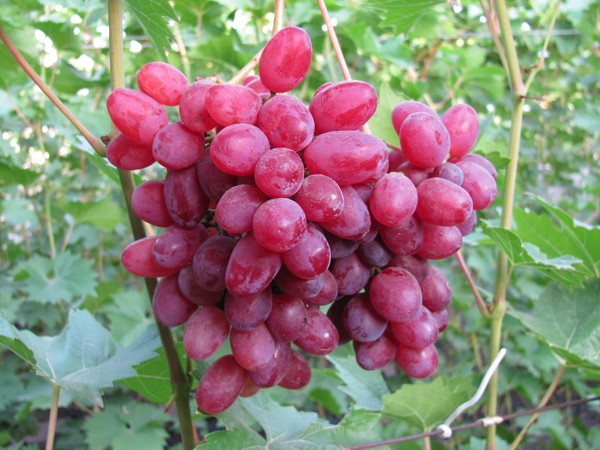

No matter how high-quality planting material is purchased, you cannot plant grapes and forget about them. Of course, Veles will bear fruit.
But the yields will not be what could be obtained with proper care, which consists in the following operations:
- Timely katarovka. That is, all surface roots are removed, coming from the underground trunk at a depth of about 20 cm. Such an agricultural technique allows the bush to be fed with roots located deeper.
- Wreckage. It is carried out when the buds of inflorescences can be distinguished on the shoots. Remove all barren ones and those that grow on wood. If the bush is overloaded, then part of the fruiting shoots is also broken off.
- Dry and green garter. Green shoots are tied up 3-4 times per season.
- Stealing. The operation is carried out mainly in the northern regions. Part of the stepchildren is removed, this contributes to the thinning of the green mass of the bush. And as a result, the berries ripen faster, and the risk of fungal diseases affecting the bushes is also reduced.
- Irrigation. In order not to carry water in buckets under each bush, it is better to carry out drip irrigation along the rows. It will justify itself, since the water consumption is much lower.
- Loosening and removing weeds.
- Top dressing with mineral fertilizers.
- Shelter for the winter. It is desirable to do this in temperate latitudes. In the southern regions, the vine is not covered, but simply mounds are raked near the trunk.
But among the most basic care operations are the prevention of diseases and autumn or spring pruning, the formation of a bush and its load.
Care features
Caring for grapes of this variety is not much different from working with other plants. Veles requires timely watering, fertilization, spraying, pruning and insulation.
The soil must be systematically moistened. It should not dry out completely. Excess moisture can lead to decay of roots and berries, which should not be allowed.
Watering is carried out 4 times:
- during blooming of leaves;
- during the flowering period;
- when the brushes are formed;
- after harvest.
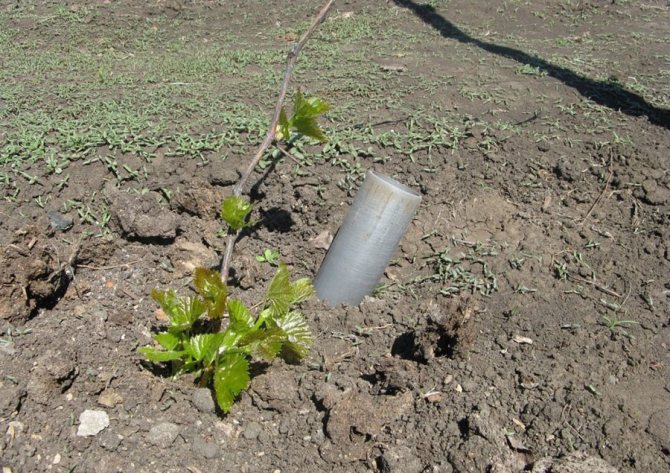

To keep moisture in the soil, it is recommended to mulch the hole. For this, both straw and humus are suitable, which will serve as fertilizer.
More careful care is required for a young plant. It is necessary to constantly remove weeds, loosen the soil, while not damaging the roots. If you cover the ground near the plant with peat, then the amount of work is reduced. Weeds grow less and moisture is better retained in the soil.
The grapes must be supported when planting. It is best to dig it in. For the frame, you will need a strong wire that must support the weight of the vines and bunches. Vaulted structures are the most durable. It is necessary to leave at least 3 meters between the trellises so that it is convenient to care for the plants, and they do not block the light from each other.

